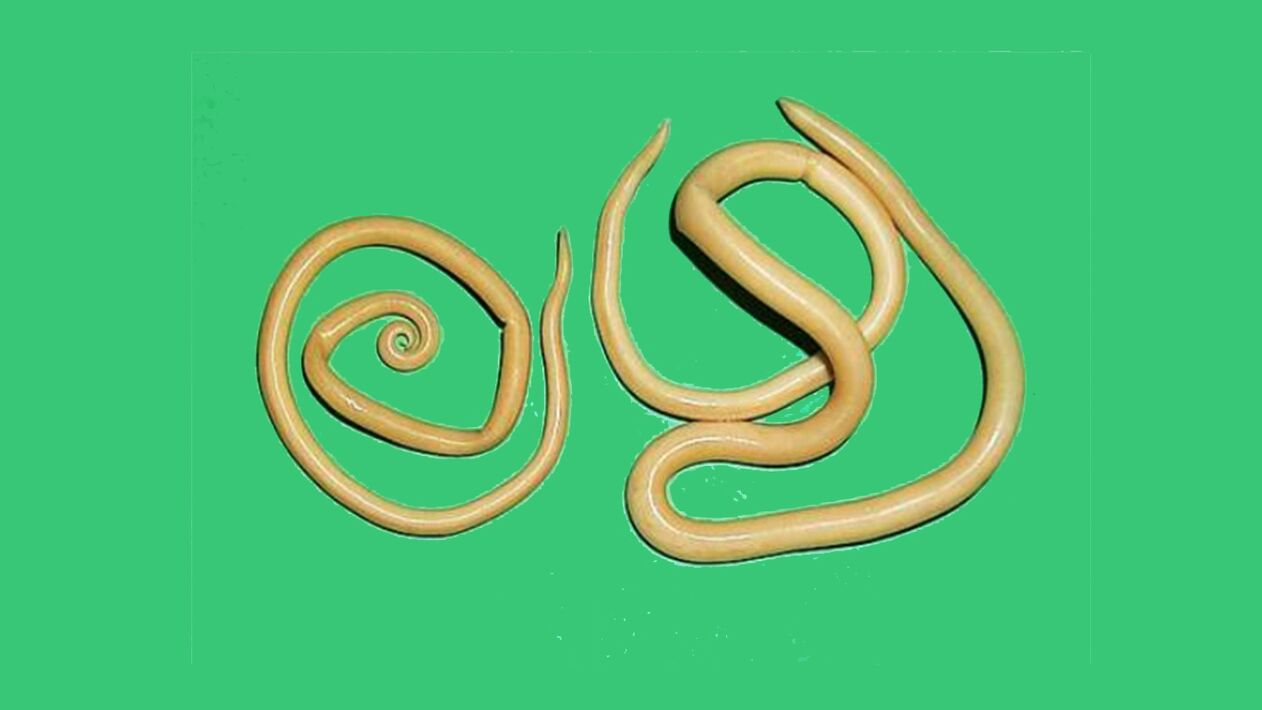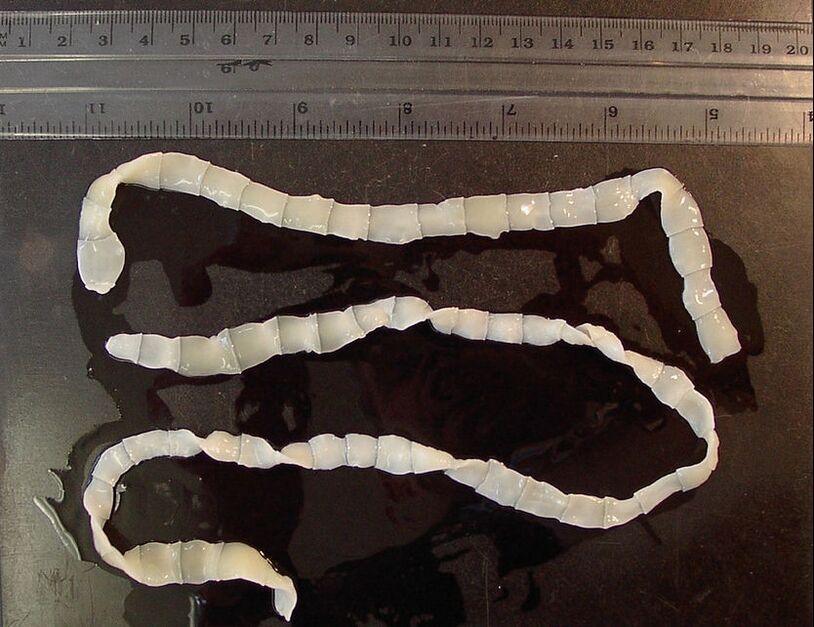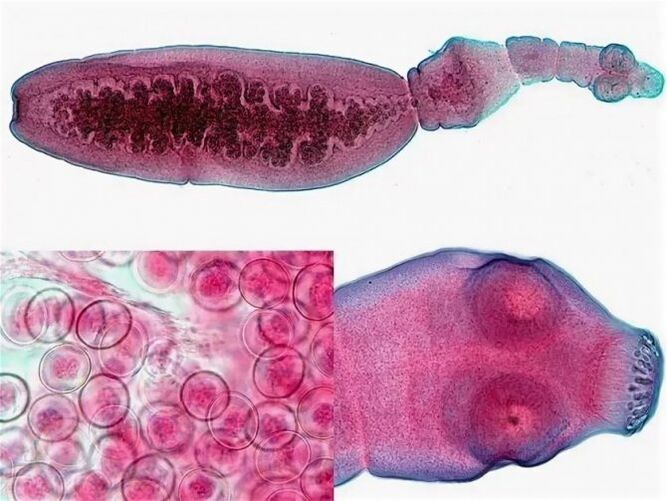
Pinwormsare regular visitors in child groups. This is a medium sized (up to 1 cm long) resident in the small and large intestines, laying eggs, leaving the rectum, on folds in the skin, underwear and bed. This happens more often at night, accompanied by intense itching in the anus. Pinworm eggs ripen after 4-6 hours and are ready to cause disease, they are perfectly preserved in the environment. They enter the human body with dust, with dirty hands, through soft toys, underwear, dishes.
Diagnosis - it is necessary to scrape the skin around the anus and examine it under a microscope, at least 3 times, 3 days apart.
When detecting pinworm eggs, the entire family of infected people should see a doctor.
In the world, about 350 million people are infected with intestinal helminthiasis, when a family member is infected, the risk for all households is very high.
Toxocara - parasite
Toxocarais a parasite in the dog's digestive system. In the US and Europe, 80% of puppies and more than 50% of adult dogs have Toxocariasis. Human surveys show that up to 37% of the population is sensitive to Toxocara antigens. This means that these individuals have been or are carriers of toxocara.
Toxocara is up to 30 cm long, in this form it lives in the body of its permanent owner - a dog. The dog discharges the toxin eggs into the sand, soil, where they can last for several years. With the sand, they fall into the hands of children playing in the sandbox, and even stick to shoes and clothes. Entering humans is a deadly pathway for the parasite, as the larvae mature, spread through the vessels and internal organs, but are not prominent.
For diagnosis, stool analysis is not informative at all, it is necessary to biopsy the affected organs (usually the liver) and immunological tests.
The most tragic is that toxocar is drowned in the eye (from 15% of the world's eyes have to be amputated due to toxocara), the lung, heart, brain, and muscle damage are also uncomfortable - fever, cough, enlarged liver, lymphadenitis, skin rash, neurological and psychiatric disorders, seizures.
Roundworm - a parasite

Roundworm- affects 100 million people annually. It enters people with food (usually undercooked herbs, vegetables and fruits), raw water, dirty hands, dust, and is actively carried by flies. The length of roundworm is up to 40 cm, each day a female roundworm secrete 200, 000 eggs, they burrow into the soil and are well preserved in it for years. Swallowed roundworm eggs in the abdomen will turn into larvae in the small intestine, then enter the intestinal wall, enter the blood capillaries, are carried to the liver, brain, eyes, heart and lungs. During movement, the roundworm eats blood - red blood cells and nutrients. Anemia (anemia) is a frequent companion of roundworm disease.
The movement of larvae causes allergies in humans, pain throughout the body, fever, increased risk of asthma, arthritis, neurodermatitis, eczema, seizures. If it enters the lungs due to a rupture of a blood vessel, it is possible to hemorrhage and cough up blood, on X-ray film - infiltration, as in a tuberculosis process.
Moving along the bronchi to the oropharynx, the roundworm has phlegm into the mouth, and from there - into the esophagus, stomach, and intestines. In the intestine, roundworms are retained, leaning against the intestinal wall, causing inflammation, infiltration and hemorrhage. Complications can occur when the roundworm enters the sinuses, liver, bile ducts, pancreas and kidney. There is intestinal obstruction, supporting processes in the abdominal cavity. Diagnosis is based on fecal analysis (at least 3 times), immunological tests - in the larval period.
Hookworms - a parasite
Hookworms- can enter people through the skin while walking barefoot (leaving no trace), as do roundworms through the mouth. Hookworm size - up to 1. 5 cm, migrates and causes the same damage as roundworm. One characteristic is symptom such as an itchy rash in the limbs and more pronounced anemia.
Integral analysis, for most intrusions, needs to be done at least 3 times.
Wide ribbon - parasite

Wide tapewormis a species with large long liver,length of an individual up to 10 meters, life expectancy in human body up to 25 years.Can you imagine what would have happened in a person if there were so many hundred-year-olds inside?
Imagine how a helminth is in the gut, how little space is left in the human gut! If the worm "stretches", half of its length will stick out! In this way, the worm absorbs all necessary substances and is useful for itself by the entire surface of the body.
You can become infected by eating raw fish, crayfish and caviar, without enough salt. Symptoms of a tapeworm can be anemia, exhaustion, abdominal pain, especially warning signs such as increased salivation in the morning, vomiting, nausea, weakness, coma, drowsiness. Bowel obstruction is possible.
A completely stunned effect on an unprepared person is created when the parasite's "tail" has been severed from the gut - a feature of the tapeworm that helps in diagnosis. .
Bovine tapeworms are parasites
Beef and pig tapeworms are parasites that enter the human body with raw meat, meat products, and lard.
The length of an adult bovine tapeworm is up to 7 meters, that of a pig tapeworm can be up to 2 meters, a lifespan of up to 20 years, and the main danger is the migration oflarvae, they are capable of penetrating even into the eyes and brain.
Echinococcus and Alveococcus - parasite

Echinococcus and alveococcus are parasites that a person becomes infected when in contact with a pathogen, drinking contaminated water, swallowing berries and soil vegetables.
The larvae travel from the intestine through the bloodstream and travel through the body into the liver, lungs, kidneys, bones and brain. The larvae transform into a cyst, which develops by pushing and squeezing surrounding tissue. Symptoms depend on the location of the cyst and the degree of compression of the organs.
Cyst rupture is a very serious complication.
Giardia - parasite
Giardiais the simplest parasite of the whip class. It is pear shaped, 10–20 µm long; Convex dorsal surface, concave abdominal surface forming suction sensory to temporarily attach to epithelial cells of host intestine. 2 oval figures, 4 pairs of whip feathers. It lives in the human intestine (mainly in children), mainly in the duodenum, rarely in the bile ducts and gallbladder, causing giardia. Asymptomatic carriers are common. Cyst infection occurs when protozoa enter the lower intestine through the mouth when contaminated food or water enters the body, as well as through dirty hands, etc. v. The incidence of the disease is sporadic. Giardiasis is common in all parts of the world.



































